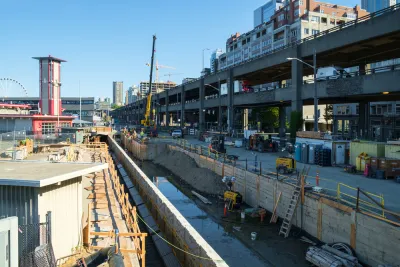A low unemployment rate means major investments by the federal government could ultimately harm the economy.

Tales of American’s failing infrastructure are not new, but, in recent months, they do seem to have increased in number and become more urgent in tone.
That does not, however mean that it’s the right moment to invest in major projects, writes Evan Horowitz at FiveThirtyEight, because “[w]hile inking an infrastructure deal is tricky under the best of circumstances, now is a particularly bad time — because the economy is just too strong.”
That’s because infrastructure spending (and the corresponding creation of jobs) benefits the economy when the government is providing jobs to the unemployed, but not when workers are leaving one job for another.
“[I]n today’s economic climate, where unemployment is nearing a 50-year low, even a massive infrastructure bill would likely generate only a trivial number of new jobs. Instead, the government would have to fill its construction crews by poaching private-sector workers, which could potentially create an inflation-generating war for scarce workers and neutralize many of the economic benefits commonly associated with large-scale government spending.”
Of course, for anyone living with failing infrastructure, or anyone in desperate need of a project with soaring costs, how the Federal Reserve feels about the unemployment rate does not feel particularly relevant.
Even if it means risking a negative impact on the economy, Horowtiz writes, "that still leaves one perfectly good reason to support such spending: It improves America’s crumbling infrastructure. But skeptics can point to the economic risks as a reason to say, yet again, ‘Let’s fix our infrastructure some other time.'"
FULL STORY: America May Finally Be Ready To Fix Its Infrastructure. Too Bad The Timing Stinks.

National Parks Layoffs Will Cause Communities to Lose Billions
Thousands of essential park workers were laid off this week, just before the busy spring break season.

Retro-silient?: America’s First “Eco-burb,” The Woodlands Turns 50
A master-planned community north of Houston offers lessons on green infrastructure and resilient design, but falls short of its founder’s lofty affordability and walkability goals.

Delivering for America Plan Will Downgrade Mail Service in at Least 49.5 Percent of Zip Codes
Republican and Democrat lawmakers criticize the plan for its disproportionate negative impact on rural communities.

Test News Post 1
This is a summary

Test News Headline 46
Test for the image on the front page.

Balancing Bombs and Butterflies: How the National Guard Protects a Rare Species
The National Guard at Fort Indiantown Gap uses GIS technology and land management strategies to balance military training with conservation efforts, ensuring the survival of the rare eastern regal fritillary butterfly.
Urban Design for Planners 1: Software Tools
This six-course series explores essential urban design concepts using open source software and equips planners with the tools they need to participate fully in the urban design process.
Planning for Universal Design
Learn the tools for implementing Universal Design in planning regulations.
EMC Planning Group, Inc.
Planetizen
Planetizen
Mpact (formerly Rail~Volution)
Great Falls Development Authority, Inc.
HUDs Office of Policy Development and Research
NYU Wagner Graduate School of Public Service





























